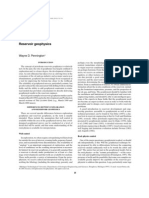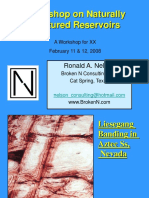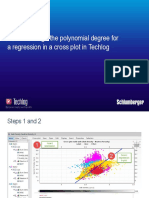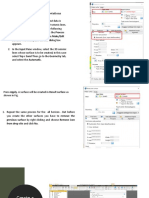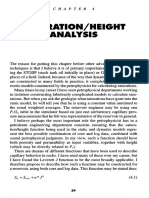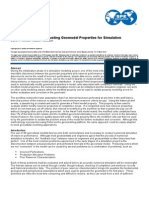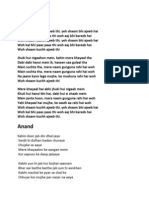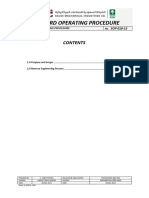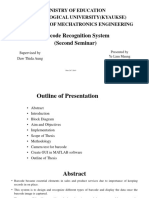Log Editing
Log Editing
Uploaded by
VivekSonkerCopyright:
Available Formats
Log Editing
Log Editing
Uploaded by
VivekSonkerOriginal Description:
Copyright
Available Formats
Share this document
Did you find this document useful?
Is this content inappropriate?
Copyright:
Available Formats
Log Editing
Log Editing
Uploaded by
VivekSonkerCopyright:
Available Formats
DATA QUALITY, EDITING, DATA QUALITY, EDITING,
AND RECONSTRUCTION AND RECONSTRUCTION
WIRE.GR_8
GAPI 0 200
WIRE.CALI_2
MM 150 400
WIRE.CALS_1
MM 150 400
2350
2400
2450
2300.0
D
E
P
T
H
M
E
T
R
E
S
WIRE.DT_1
US/M 700 100
WIRE.RHOB_1
K/M3 1950 2950
WHY DO WE EDIT LOG DATA? WHY DO WE EDIT LOG DATA?
2350
2400
2450
WIRE.DT_1
US/M 700 100
WIRE.DT_7
US/M 700 100
WIRE.RHOB_1
K/M3 1950 2950
WIRE.RHOB_13
K/M3 1950 2950
Sonic Density
DONT THE LOGS
MEASURE WHAT
THEYRE DESIGNED
TO MEASURE?
2450
2500
2550
2600
2650
2700
2750
2800
2850
2875.0
RCHD
TGLU
RCHD
TGLU
2450
2500
2550
2600
2650
2700
2750
2800
2850
RCHD
TGLU
RCHD
TGLU
For best results, it requires some
knowledge
experience
common sense, and
ALL CURVES !
BASIC EDITING WORKFLOW BASIC EDITING WORKFLOW
LOAD ALL DATA
UNDERSTAND WHAT YOUVE GOT
MERGE LOGGING RUNS (CREATE COMPOSITE LOGS)
ENVIRONMENTAL CORRECTIONS (if necessary)
NORMALIZATION (if necessary)
ENVIRONMENTAL CORRECTIONS (if necessary)
NORMALIZATION (if necessary)
BASIC EDITING WORKFLOW BASIC EDITING WORKFLOW
IDENTIFY AND FLAG BAD DATA
DEPTH SHIFTS
I
D
E
N
T
I
F
Y
A
N
D
R
E
P
A
I
R
B
A
D
D
A
T
A
GENERATE PSEUDO DATA
REPLACE BAD DATA WITH PSEUDO DATA
MULTIWELL TREND PLOTS AND HISTOGRAMS TO QC
I
D
E
N
T
I
F
Y
A
N
D
R
E
P
A
I
R
B
A
D
D
A
T
A
UNDERSTAND WHAT YOUVE GOT
SOME KEY QUESTIONS:
HOW MANY LOGGING RUNS?
UP-LOGS OR DOWN LOGS?
MUD SYSTEMS MUD SYSTEMS
MUD LOGS AVAILABLE?
CORE DATA AVAILABLE?
CASING POINTS
AVAILABLE CURVES
UNITS
Some common LAS naming practices:
MP, MAINMAIN PASS
RP,RPT REPEAT SECTION
UNDERSTAND WHAT YOUVE GOT LAS FILE NAMES
RP,RPT REPEAT SECTION
TVD, TV TOTAL VERTICAL DEPTH
HR, H HIGH RESOLUTION DATA
AIT, DT TOOL STRINGS OR LOGS
Load everything in measured depth and convert to TVD using the directional
survey data.
Stay away from files measured in TVD; often mislabeled in LAS
NOTE THE FOLLOWING:
Much of what we need to know for a petrophysical
analysis can be found in the log header
information. Key pieces of information include KB
elevation, mud type, R
mf
, and casing points.
When working with neutron log data, we need to
know, prior to our analysis, the type of neutron tool
and the matrix on which the data was recorded.
Sometimes this is clearly indicated in the
mnemonic (e.g., NPLS, NCNPL), but more often
than not, we need to look in the LAS file to find this
information. Oftentimes we actually need to refer
to the hard copy of the log to find this information.
Density is also frequently presented as a porosity
curve, in which case we need to know the matrix
and fluid densities used to calculate the density
porosity.
LOAD ALL DATA
Load all data from all logging runs
Either organize the data in a coherent
database, or name the curves in such a
way that you understand when the were way that you understand when the were
run
Load repeat data!
EXAMPLE
LOAD ALL DATA
Exercise!!!
CLASS PROJECT
EVALUATE LAS FILES
LOAD BOTH LOGGING RUNS TO
POWERLOG/HRS???
LOAD ALL DATA
DEPTH
M
A_GR
GAPI 0 150
B_GR
GAPI 0 150
B_C13
MM 0 500
A_C13
MM 0 500
A_RD
OHMM 0.2 200
B_M2R9
OHMM 0.2 200
A_DT24QS
US/M 500 0
B_DT24QS
US/M 500 0
B_PORZSS
PU 40 -10
B_CNCSS
PU 40 -10
100
200
300
400
500
600
700
800
900
1000
QUESTIONS:
1) WHERE ARE THE PROBLEM DATA?
2) WHY ARE THERE NEGATIVE POROSITIES?
1000
1100
1200
1300
1400
1500
1600
1700
1800
1900
2000
2100
2200
2300
2400
2500
2600
2700
2800
2900
3000
3100
3200
3300
3400
Merge log runs to create single curves to be used
In multiwell projects, compare curves well-to-well
to check for differences in logging contractors, tool
calibration, tool type/vintage, and other
MERGE LOGGING RUNS (CREATE COMPOSIT LOGS)
calibration, tool type/vintage, and other
measurement differences.
RUN1.GR_1
GAPI 0 200
RUN2.GR_1
GAPI 0 200
SP
MV -160 40
RUN2SONIC.GR_1
GAPI 0 200
RUN1.RHOB_1
K/M3 1950 2950
RUN2.RHOB_1
K/M3 1950 2950
RUN2.PE_1
B/E 0 10
RUN1.PE_1
B/E 0 10
SP
MV -160 40
RUN1.CAL2_2
MM 150 400
RUN2.CAL2_1
MM 150 400
RUN1.CALI_1
MM 150 400
RUN2.CALI_1
MM 150 400
SP
MV -160 40
RUN1.DT_1
US/M 500 100
RUN2.DT
US/M 500 100
RUN2SONIC.DT_1
US/M 500 100
SP
MV -160 40
3375
3350.0
DEPTH
METRES
MERGE LOGGING RUNS (CREATE COMPOSIT LOGS)
3400
3425
3450
3475
3500.0
When merging curves, it is usually best to take the
uppermost curve down as far as reasonable. Having
been logged earlier in time, it is less likely to be
impacted by deteriorating borehole conditions and
additional invasion.
Merge at a point where logs are reading same,
whenever possible.
Casing point
EVALUATE AND DISCUSS CASING POINT (see next
slide)
MERGE LOGGING RUNS (CREATE COMPOSIT LOGS)
MERGE LOGGING RUNS
MERGE LOGGING RUNS (CREATE COMPOSITE LOGS)
DEPTH
M
A_GR
GAPI 0 150
B_GR
GAPI 0 150
B_C13
MM 0 500
A_C13
MM 0 500
A_RD
OHMM 0.2 200
B_M2R9
OHMM 0.2 200
A_DT24QS
US/M 400 100
B_DT24QS
US/M 400 100
B_PORZSS
PU 40 -10
B_CNCSS
PU 40 -10
SPL_GR
API 0 150
1525
1550
GAMMA RAY MERGE
- WHAT IS WRONG WITH THIS?
MERGE POINT
1575
1600
1625
1650
1675
IS THE DATA ACROSS
THIS ZONE USEFUL?
WHY OR WHY NOT?
MERGE THE REMAINDER OF THE CURVES
MERGE LOGGING RUNS (CREATE COMPOSITE LOGS)
As with anything in petrophysics, I like to be very consistent (if possible) with my
naming conventions. When I splice curves together, I usually prefix the new
curve with an SPL_*. If I do multiple splices during the editing process, I add a
version number to the splice. For instance, if I do further splice work on the GR
curve, the new curve will become SPL2_GR. If you are reasonably consistent, it
will be relatively easy to remember what you did at a later date.
ENVIRONMENTAL CORRECTIONS (if necessary)
CONTRACTOR SPECIFIC CORRECTIONS
CORRECT FOR BOREHOLE CONDITIONS
MOST MAKERS OF PETROPHYSICAL SOFTWARE
Most of us dont typically apply environmental corrections. There are numerous reasons for this, but in
general it is because the magnitude of the corrections are small, and the uncertainties in how they are
applied are large (most frequently, we dont even have the requisite data to apply the corrections).
GR is about the only log I will sometimes correct, simply because the changes can be large and
important. Note, however, that the corrections to the GR can often be too large!
MOST MAKERS OF PETROPHYSICAL SOFTWARE
HAVE SIMPLY DIGITIZED THE PUBLISHED
CHARTS
DEPTH
FT
DCAL
IN -5 5
DCAL 0
GR
GAPI 0 150
CORE_GR
API 0 150
GRC
api 0 150
DSCOREGR
API 0 150
10700
10710
10720
10730
10740
ENVIRONMENTAL
CORRECTIONS TO GR
MINOR DEPTH SHIFT OF
CORE DATA
ENVIRONMENTAL CORRECTIONS (if necessary)
10740
10750
10760
10770
10780
10790
10800
10810 RAW DATA CORRECTED GR
AND DEPTH-
SHIFTED CORE
DATA
NORMALIZATION (if necessary)
1
.
0
0
1
.
1
0
1
.
2
0
1
.
3
0
1
.
4
0
1
.
5
0
1
.
6
0
1
.
7
0
1
.
8
0
1
.
9
0
2
.
0
0
0.150 0.150
PHIE_CALIB vs. DT4S/DT4P Crossplot
Well: 3 Wells
Intervals: BLUSKY, GETHNG, CADOMN
Filter:
2286
2327
34
0
07
0.150 0.150
Sands and shales of Bluesky, Gething, Cadomin
Note that the shales (phie<.02) also show the disparity
in Vs. Thus, it does not appear to be isolated to sands
Vp about the same for all 3 wells
When curves from different wells have observable differences, we should first look for geological explanations. If
that fails, then we must consider tool or measurement errors. When we normalize curves, we always run the risk
of removing real differences and perhaps the very properties we are interested in.
1
.
0
0
1
.
1
0
1
.
2
0
1
.
3
0
1
.
4
0
1
.
5
0
1
.
6
0
1
.
7
0
1
.
8
0
1
.
9
0
2
.
0
0
0.000 0.000
0.015 0.015
0.030 0.030
0.045 0.045
0.060 0.060
0.075 0.075
0.090 0.090
0.105 0.105
0.120 0.120
0.135 0.135
P
H
I
E
_
C
A
L
I
B
(
V
/
V
)
DT4S/DT4P ()
Shales
0.030 0.030
0.045 0.045
0.060 0.060
0.075 0.075
0.090 0.090
0.105 0.105
0.120 0.120
0.135 0.135
P
H
I
E
_
C
A
L
I
B
(
V
/
V
)
in Vs. Thus, it does not appear to be isolated to sands
(composition, diagenesis, etc). May be tool issues.
2
0
0
0
2
4
0
0
2
8
0
0
3
2
0
0
3
6
0
0
4
0
0
0
4
4
0
0
4
8
0
0
5
2
0
0
5
6
0
0
6
0
0
0
1
2
0
0
1
5
0
0
1
8
0
0
2
1
0
0
2
4
0
0
2
7
0
0
3
0
0
0
3
3
0
0
3
6
0
0
3
9
0
0
Vs is not
VpVs Ratio
DEPTH SHIFTS
DEPTH
M
B_GR
GAPI 0 150
B_C13
MM 0 500
( )
0 500
B_M2R9
OHMM 0.2 200
B_DT24QS
US/M 400 100
B_PORZSS
PU 40 -10
B_CNCSS
PU 40 -10
2520
2530
2540
WHICH CURVE IS OFF DEPTH?
HOW DO YOU KNOW?
2550
2560
2570
2580
2590
2600
2610
For effective depth shifting, pick a reference curve you believe (usually
shallow resistivity or first-run GR: has good character and vertical
resolution)
Be careful of too many shifts up and down. Fewer is better. As with
seismic data, you can get off a cycle if youre not careful.
DEPTH SHIFTS
NOTE: DEPTH-SHIFTING CANNOT CURRENTLY BE DONE IN H-R
CLASS EXCERSIZE: WE WILL SCROLL DOWN THROUGH THE
LOG, AND INTERACTIVELY DEPTH SHIFT THE SONIC LOG
IDENTIFY AND FLAG BAD DATA
I
D
E
N
T
I
F
Y
A
N
D
R
E
P
A
I
R
B
A
D
D
A
T
A
IDENTIFICATION AND REPAIR OF IDENTIFICATION AND REPAIR OF
BAD DATA BAD DATA
GENERATE PSEUDO DATA
REPLACE BAD DATA WITH PSEUDO DATA
I
D
E
N
T
I
F
Y
A
N
D
R
E
P
A
I
R
B
A
D
D
A
T
A
KEY POINT: tool readings do not reflect the properties of the formation
We will look at some examples and discuss:
Although the terms bad data and badhole are not particularly scientific, nor
perhaps grammatically correct, they are the common terminology among log
analysts. Be aware when conversing with log analysts, however, as they will often
differentiate between truly bad data (i.e., tool failure), vs. valid tool readings in poor
borehole conditions. As seismic petrophysicists, we want to edit the log data such
that it represents what we believe to be the true formation properties.
WHAT IS BAD DATA? WHAT IS BAD DATA?
We will look at some examples and discuss:
Causes some typical reasons for bad data
- (obvious things you should always check first)
Recognition practices to identify poor quality data
- (some ways to recognize and isolate bad data)
Edits and Reconstruction useful methods to repair curves
We will focus on the two slowness curves and density
12700
12800
12900
13000
13100
Type G sand
Logrun break clearly indicated by
bitsize change, caliper, straight
lined curves
Resistivity and neutron-density
separation suggest no sand here
THE EASIEST: CASING POINT PROBLEMS THE EASIEST: CASING POINT PROBLEMS
13200
13300
13400
13500
13600
13700
13800
13900
ALWAYS REFER TO LOG
HEADER INFORMATION!
BEWARE OF CASING POINT
PROSPECTS!
COMMON LOG DATA PROBLEMS COMMON LOG DATA PROBLEMS
BS_1
MM 150 400
CALI_2
MM 150 400
GR_2
GAPI 0 200
SP_1
MV -160 40
3125
3115.0
DEPTH
METRES
DT_2
US/M 500 100
NPHI_1
V/V 0.45 -0.15
RHOB_2
K/M3 1950 2950
PEFZ_1
B/E 0 10
SFL
OHMM 0.2 2000
ILM
OHMM 0.2 2000
AF90_1
OHMM 0.2 2000
LLD
OHMM 0.2 2000
Tool problems (dead)
Log run breaks
Hole conditions
Cycle skips
3150
3175
3200
3215.0
Cycle skips
Tool pulls
Casing
Mud and mud cake
Digitizing errors
Depth shifts
BS
MM 150 400
CALI_1
MM 150 400
GR_1
GAPI 0 150
800
775.0
DEPTH
METRES
DT_1
US/M 500 100
DTSM
US/M 1200 200
WIRE.DEN_1
K/M3 1950 2950 0.2
0.2
0.2
Tool problems
Log run breaks
Hole conditions
Tails
Cycle skips
Tool pulls
Casing
Poor hole
conditions
COMMON LOG DATA PROBLEMS COMMON LOG DATA PROBLEMS
825
850
875
900.0
Casing
Mud and mud cake
Digitizing errors
Depth shifts
Cycle Skips
In this example, we see poor hole
conditions affecting the density logs. The
same hole conditions are causing cycle
skipping on this sonic data.
WHAT IMPORTANT QUESTION
SHOULD WE BE ASKING ABOUT THE
REASONS FOR THE BOREHOLE
PROBLEMS?
CALS_1
MM 150 400
CAX_1
MM 150 400
GR_5
GAPI 0 200
SP_6 0 100
2650
2625.0
D
E
P
T
H
POL_1
V/V 0.6 0
RHOB_2
K/M3 1650 2650
VSH_3
V/V 0 1
PHIE_1
V/V 1 0
VOL_UWAT_1
V/V 1 0
Tool problems (dead)
Log run breaks
Hole conditions
Tails
Cycle skips
Tool pulls
COMMON LOG DATA PROBLEMS COMMON LOG DATA PROBLEMS
KCL mud was used to drill this well. KCL mud was used to drill this well.
Notice the insensitivity of the GR. Notice the insensitivity of the GR.
Fortunately, SP is a reasonable Fortunately, SP is a reasonable
lithology indicator in this well. lithology indicator in this well.
2675
2700
2725
2750
2775
2790.0
Tool pulls
Casing
Mud and mud cake
Digitizing errors
Depth shifts
WHY ELSE MIGHT THE GR NOT
RESPOND TO THE RESERVOIR
SECTION?
BS_1
MM 150 400
CAL2_2
MM 50 300
CALI_2
MM 50 300
GR_2
GAPI 0 200
VSH_GR_1
V/V 0 1
3665.0
DEPTH
METRES
NPHI_2
V/V 0.45 -0.15
RHOB_2
K/M3 1950 2950
DRHO_2
K/M3 -400 100
PE_2
B/E 0 10
Tool problems
Log run breaks
Hole conditions
Tails
Cycle skips
Tool pulls
COMMON LOG DATA PROBLEMS COMMON LOG DATA PROBLEMS
3700
Tool pulls
Casing
Mud and mud cake
Digitizing errors
Depth shifts Barite mud filling fractures (or rugosity
along the borehole wall) can result in
very high RHOB and PEF readings.
Recommendations for badhole identification: Recommendations for badhole identification:
Borehole and measurement quality indicators
Log header information for log run breaks
Reasonable log values and frequency content
Comparison to other data using crossplots and
histograms
i.e., offset well data
RECOGNIZING BAD DATA RECOGNIZING BAD DATA
i.e., offset well data
Trend plots and cross-plots
Empirical curves or regression equations
Also look for consistency amongst specific lithologies
(i.e. do the curves make sense collectively!)
Our ability to recognize poor quality log data will depend
on our understanding of the following:
local geology
tool responses, and
the borehole environment
1600
300
400
500
600
700
800
900
UNDERSTANDING THE GEOLOGY WILL HELP TO
UNDERSTAND QUALITY vs. BAD LOG DATA.
ALWAYS LOOK AT LOGS USING A VARIETY OF VERTICAL SCALES! ALWAYS LOOK AT LOGS USING A VARIETY OF VERTICAL SCALES!
1700
1000
1100
1200
1300
1400
1500
1600
1700
1800
How much of this spiky data is bad?
Closer examination of the data shows that much of the
spikiness may be due to geology. Editing out these
spikes would be inappropriate!
DEPTH
FT
A_GR
GAPI 0 200
A_HCAL
IN 6 16
A_HCGR
GAPI 0 200
A_RLA5
OHMM 0.1 10000
A_RLA3
OHMM 0.1 10000
A_RLA1
OHMM 0.1 10000
RAW_RHOB
g/cc 1.95 2.95
A_NPHI
CFCF 0.45 -0.15
A_PEFZ
0 10
RAW_VP
ft/s 10000 25000
500
1000
1500
2000
2500
VALID DATA? VALID DATA?
2500
3000
3500
4000
4500
5000
5500
6000
6500
7000
7500
NOTE:
Washout on caliper
Anomalously low density values
Velocity drop
A_HCAL
IN 6 16
A_HCGR
GAPI 0 200
A_RLA3
OHMM 0.1 10000
A_RLA1
OHMM 0.1 10000
A_NPHI
CFCF 0.45 -0.15
A_PEFZ
0 10
RAW_RHOB A_NPHI
1000
1500
VALID DATA? VALID DATA?
KEY POINT: under certain circumstances, the wellbore can be badly washed-out, but
the density is still recording valid values. In this instance, some editing is
still required, but the general trend of the density and velocities is
correct. It is best if you know something about the local, or sub-regional,
geology!!
2000
2500
3000
CREATE BAD HOLE FLAG
It is frequently useful to create a flag curve that highlights those parts of the
well-bore that contain bad data. This badhole flag can be used when
generating pseudo data (when you only want to train on the good data), or
during cross-plot analysis (when you want to cross-plot only the very best data
in the well).
There are two approaches I generally take to create a BADHOLE flag. The
quickest and easiest is to automate the process, using the caliper and density
correction data (DRHO). The second approach is more interpretive, and
involves visually selecting the zones over which you think there is bad data.
There are strengths and weaknesses to each approach (we will discuss these
in class).
NOTICE THAT DENSITY IS NOT
NECESSARILY BAD EVERYWHERE
THERE IS WASHOUT OR LARGE
DENSITY CORRECTIONS. BE
BE CAREFUL WHEN AUTOMATING
THE PROCESS OF CREATING A
BADHOLE FLAG!
CALIPER
DRHO
HOLE QUALITY HOLE QUALITY
Be careful when Drho > 100 kg/m3
(+) correction when mud and large hole
size cause density to read too low
(common)
() correction when heavy mud or small
borehole diameter
Sonic appears to
be largely
unaffected by the
washouts
CREATE BAD HOLE FLAG
Automating the process gives you a more quantitative
approach to identifying bad hole. As we discussed on the
previous slide, however, automating the process may also
exclude bad data, or include valid data.
Hand-picking bad data gives the interpreter more lee-
way on deciding just what is bad data. However, bear in
mind that it is now an interpretive decision! mind that it is now an interpretive decision!
REMEMBER: DCAL = CALI - BITSIZE
DEPTH
FT
GR
GAPI 0 150
DCAL
IN -5 5
AT90
OHMM 0.2 2000
AT30
OHMM 0.2 2000
AT10
OHMM 0.2 2000
RAW_RHOB
g/cc 1.95 2.95
NPHI
V/V 0.45 -0.15
PEFZ
---- 0 20
HDRA
G/C3 -1 1
RAW_VP
km/s 2 7
1000
1500
2000
2500
3000
3500
4000
4500
5000
BADHOLE from automated process
Hand-picked BADHOLE
DEPTH
FT
GR
GAPI 0 150
DCAL
IN -5 5
AT90
OHMM 0.2 2000
AT30
OHMM 0.2 2000
AT10
OHMM 0.2 2000
RAW_RHOB
g/cc 1.95 2.95
NPHI
V/V 0.45 -0.15
PEFZ
---- 0 20
HDRA
G/C3 -1 1
RAW_VP
km/s 2 7
4300
4400
ZONE OF INTEREST
4500
4600
4700
4800
COMMON PROBLEMS
Digitizing errors
Differences in tool type / contractor / vintage
REPAIR TECHNIQUES
OTHER SOURCES OF BAD DATA OTHER SOURCES OF BAD DATA
IF POSSIBLE, USE MULTIPLE WELLS IN AN AREA TO DETERMINE WHETHER OR NOT IF POSSIBLE, USE MULTIPLE WELLS IN AN AREA TO DETERMINE WHETHER OR NOT
YOUR LOG CURVES ARE RECORDING REASONABLE VALUES. YOUR LOG CURVES ARE RECORDING REASONABLE VALUES.
Re-digitize
Normalization
Rescaling
2450
2500
2550
2600
2650
2700
2750
2400.0
TGLU
DT LOOKS NORMAL
1
0
0
1
6
0
2
2
0
2
8
0
3
4
0
4
0
0
4
6
0
5
2
0
5
8
0
6
4
0
7
0
0
0 0
500 500
1000 1000
1500 1500
2000 2000
2500 2500
DEPTH vs. WIRE_INT5.DT_SMT Crossplot
Well: 7 Wells
Range: All of Well
Filter:
D
E
P
T
H
(
M
E
T
R
E
S
)
4354
4354
0
0
00
Beware can be hard to catch.
DIGITIZING ERRORS DIGITIZING ERRORS
2800
2850
2900
2950
3000
3050
3100
3150
3200
3250
3312.5
1
0
0
1
6
0
2
2
0
2
8
0
3
4
0
4
0
0
4
6
0
5
2
0
5
8
0
6
4
0
7
0
0
3000 3000
3500 3500
4000 4000
4500 4500
5000 5000
D
E
P
T
H
(
M
E
T
R
E
S
)
WIRE_INT5.DT_SMT (US/M)
Well Legend:
300C426930134450 300D556930134450
300F436930134450 300G336930134450
300H066930135000 300H546930134450
300P036930135000
Functions:
ri_ne_opress : No description given.
xtrend_ri_ne : No description given.
Sometimes log data looks normal in terms of frequency content and correlation
to other logs but can be much different when compared to offset well data.
Digitizing errors can be difficult to identify using only the log display.
Always go back to the hardcopy logs for verification !
LOOK FOR SCALE CHANGES THAT THE DIGITIZER MAY HAVE
MISSED!
5
0
0
1
5
0
0
2
5
0
0
3
5
0
0
4
5
0
0
5
5
0
0
6
5
0
0
7
5
0
0
500 500
1000 1000
1500 1500
2000 2000
DEPTH vs. 1000000/ESSO_INT.DT Crossplot
Well: 7 Wells
Range: All of Well
Filter:
D
E
P
T
H
(
M
E
T
R
E
S
)
7001
7277
275
0
01These erroneous logs can hang around for
a long time particularly with the multiple
data sources available to geoscientists
Heres a number of velocity logs still being
used today although they were drilled in
the mid 1980s into the 3.0 Tcf Taglu field
VELOCITY VELOCITY- -DEPTH CALIBRATION DEPTH CALIBRATION
5
0
0
1
5
0
0
2
5
0
0
3
5
0
0
4
5
0
0
5
5
0
0
6
5
0
0
7
5
0
0
2500 2500
3000 3000
3500 3500
4000 4000
4500 4500
5000 5000
D
E
P
T
H
(
M
E
T
R
E
S
)
1000000/ESSO_INT.DT (US/M)
Well Legend:
300C426930134450 300D436930134450
300D556930134450 300G336930134450
300H066930135000 300H546930134450
300P036930135000
the mid 1980s into the 3.0 Tcf Taglu field
in the Mackenzie Delta
SHOULD DATA BE HUNG
STRUCTURALLY OR
STRATIGRAPHICALLY?
As we have seen, many logs measure
similar properties of the formation (e.g.
matrix, porosity), and we expect there to
be reasonable correlation between them.
Log analysts use the collective behavior
of curves to do qualitative formation
CALI_RES_1
MM 100 350
GR_2
GAPI 0 200
SP_5
MV -25 75
780
785
790
775
772.0
DEPTH
METRES
NPHI_2
V/V 0.6 0
RHOB_2
K/M3 1650 2650
PE_3
B/E 0 10
DT_2
US/M 500 100
DTSM_1
US/M 2400 200
SFL_1
OHMM 0.2 200
ILM_1
OHMM 0.2 200
ILD_1
OHMM 0.2 200
PATTERN MATCHING PATTERN MATCHING
of curves to do qualitative formation
evaluation as will we. Qualitative
interpretations help to identify log data
that just doesnt fit our expectations.
795
805
810
815
820
830
835
800
825
839.5
IDENTIFY AND FLAG BAD DATA
I
D
E
N
T
I
F
Y
A
N
D
R
E
P
A
I
R
B
A
D
D
A
T
A
IDENTIFICATION AND REPAIR OF BAD DATA IDENTIFICATION AND REPAIR OF BAD DATA
GENERATE PSEUDO DATA
REPLACE BAD DATA WITH PSEUDO DATA
I
D
E
N
T
I
F
Y
A
N
D
R
E
P
A
I
R
B
A
D
D
A
T
A
GENERATING PSEUDO DATA GENERATING PSEUDO DATA
When repairing bad data, we often times use simple hand-patches. However, this approach becomes
unwieldy when trying to process thousands of feet of data. Therefore, it is frequently useful to generate
pseudo data. This is generally done via application of an empirical transform, or via application of multilinear
regression or neural network analysis. Empirical relationships typically use one log to compute an unknown.
For example, Gardners famous relationship uses P-wave velocities to estimate density. Although the
empirical transforms are often very useful, I prefer to use multilinear regression when generating pseudo
data. This allows the user to include more than one curve type when estimating an unknown.
In this section we will focus on practical (meaning time-efficient) methods of editing sonic and density data.
We will cover the empirical relationships, but also application of multilinear regression and neural net analysis.
We will also explore the various options that Hampson-Russell gives the user for generating pseudo data.
EMPIRICAL RELATIONSHIPS
Compressional Velocity
Faust: Dt = 513.3 / (Depth*Rt)**(1/6)
Density
Gardner: Gardner: Rhob = 0.23 * Vp**(1/4) (Vp in ft/s; rhob in g/cc)
Gardner-Castagna: Rhob = fcn(Vp,Vsh)
Shear Velocity
Greenburg-Castagna coefficients
affected by local stresses and formation properties
also affected by invasion and near-wellbore alteration
these issues will be discussed later today and tomorrow morning
USED TO ACQUIRE FORMATION VELOCITIES
SONIC LOGS SONIC LOGS
Schematic of Schlumbergers long
spaced sonic tool. Taken from
Bassiouni.
Note that sonic tools are run centered
(ostensibly) in the wellbore.
MONOPOLE (primarily P-wave velocities) AND
DIPOLE SOURCES (P- and S-wave velocities)
NOTE: sonic logs can be thought of as refraction devices. Thus, you need to have
a critical angle to receive a signal (we will discuss critical angle later in the class).
What does this mean for the lower limit of velocities we can detect with sonic tools?
transmitters emit a pulse, which is recorded by an array of receivers
records transit time between receivers
TWO METHODS FOR MEASURING SONIC TRANSIT TIMES:
First arrival picking (older tools like BHC, LSS)
Full waveform capture entire waveform from which various arrivals are picked.
Compressional waves travel parallel to the direction of particle motion. They read
the rock matrix, fluid in the rock, and elements of pore structure.
Shear waves travel perpendicular to the direction of particle motion. They measure
SONIC LOGS SONIC LOGS
the rigidity of the formation and are influenced by the rock matrix and elements of
pore structure.
Tube waves (or Stonely waves) travel along the wellbore
FIRST ARRIVAL PICKING
SONIC LOGS SONIC LOGS
From Tang and Cheng, 2004
ADVANTAGES OF ARRAY PROCESSING:
- different moveouts for different modes
- better processing and results
FULL WAVEFORM ARRAY PROCESSING
f
=
= wavelength
= formation velocity
f = frequency
DEPTH OF INVESTIGATION IS RELATED WAVELENGTH, WHICH IS
RELATED TO THE FREQUENCY OF THE MEASUREMENT AND
THE FORMATION VELOCITY
SONIC LOGS SONIC LOGS
2000.0 4000.0 6000.0 8000.0 10000.0 15000.0 20000.0
6000.0 3.0 1.5 1.0 0.8 0.6 0.4 0.3
8000.0 4.0 2.0 1.3 1.0 0.8 0.5 0.4
10000.0 5.0 2.5 1.7 1.3 1.0 0.7 0.5
12000.0 6.0 3.0 2.0 1.5 1.2 0.8 0.6
14000.0 7.0 3.5 2.3 1.8 1.4 0.9 0.7
V
E
L
O
C
I
T
Y
(
f
t
/
s
)
FREQUENCY (Hz)
Commonly encountered ranges for the DWGOM
If low frequency data can be acquired, the sonic data will be less affected by invasion.
While sonic data is less susceptible to well-bore washout than density data,
it still frequently requires considerable editing. Editing of sonic data usually
takes the form of correction of cycle skips, and de-spiking noisy data. SONIC LOGS SONIC LOGS
WHAT DOES BAD SONIC DATA LOOK LIKE?
abundant spikes (fast and slow)
very noisy (abnormally high frequency)
too fast for the area
CYCLE SKIPS (common in older logs)
acoustic wave is attenuated below the threshold of the receive
receiver detects a later event receiver detects a later event
abnormally long travel times (records Vp that is too slow)
WHERE ARE CYCLE SKIPS LIKELY TO OCCUR?
thin beds with large velocity contrasts
gas sands
gas-cut mud
poorly consolidated formations
fractured formations
SONIC LOGS SONIC LOGS
FAST SPIKES (noise)
receivers record early noise arrivals
results in apparent fast rock
EDITING CYCLE SKIPS AND NOISE
simple approach is to simply filter the data
generate pseudo-sonic data
local calibrations local calibrations
neural networks and multilinear regression
hand edits
WHEN ARE SPIKES NOT CYCLE SKIPS OR NOISE?
must be careful to not edit lithology
coal
hard streaks (e.g., carbonate interbeds)
look for lithology indicators
compare behavior of resistivity, neutron, and density to sonic data.
Do they move in the same directions?
Cycle skips
Noise
Note the noise in the resistivity and the density data. Some of the
spikes in the sonic data may be reflecting true lithology effects
across this zone.
SIMPLE SMOOTHING
DEPTH
M
TVD
M
GR
GAPI 0 150
HCAL
MM 100 300
LCAL
MM 100 300
AHT90
OHMM 0.2 2000
AHT30
OHMM 0.2 2000
AHT20
OHMM 0.2 2000
VP_RAW
ft/s 10000 20000
DPHI_RAW
v/v 0.4 -0.1
NPHI_SS
v/v 0.4 -0.1
2750
2760
2770
2780
2710
2720
2730
RAW DATA RAW DATA
SIDERITE
My general approach is to generate
pseudo-sonic data for editing purposes.
Usually I do this via multilinear
regression. The best answers I usually
get involve resistivity, neutron, depth, and
some lithology indicator.
CADOTTE
2790
2800
2810
2820
2830
2840
2850
2860
2870
2880
2740
2750
2760
2770
2780
2790
2800
2810
2820
DEPTH
M
TVD
M
GR
GAPI 0 150
HCAL
MM 100 300
LCAL
MM 100 300
AHT90
OHMM 0.2 2000
AHT30
OHMM 0.2 2000
AHT20
OHMM 0.2 2000
VP_RAW
ft/s 10000 20000
VP_PSE
10000 20000
1400
1500
1600
1700
1400
1500
1600
1700
Multilinear regression
Typical data used for Vp
estimation:
oResistivity
oNeutron porosity
SONIC LOGS SONIC LOGS
DUNVEGAN
SHAFTSBURY
CADOTTE
1800
1900
2000
2100
2200
2300
2400
2500
2600
2700
2800
1800
1900
2000
2100
2200
2300
2400
2500
2600
2700
oN-D difference
oVshale
1
9
0
0
0
1
5
0
0
0
1
6
0
0
0
1
7
0
0
0
1
8
0
0
0
1
.
2
0
.
8
1
SONIC EDITS SONIC EDITS
BAD SONIC DATA
WELL: DEVON LYNX 6-18-61-9
VP_PSE2
9000 19000 10000 11000 12000 13000 14000 15000 16000 17000 18000
V
P
_
R
A
W
9
0
0
0
1
0
0
0
0
1
1
0
0
0
1
2
0
0
0
1
3
0
0
0
1
4
0
0
0
1
5
0
0
0
V
C
L
G
R
0
0
.
2
0
.
4
0
.
6
R
2
= 0.88
EDITED SONIC DATA EDITED SONIC DATA
DEPTH
M
TVD
M
GR
GAPI 0 150
RDEEP
ohmm 0.2 2000
RMED
ohmm 0.2 2000
RSHAL
ohmm 0.2 2000
VP_RAW
ft/s 10000 20000
VP_FINAL
ft/s 10000 20000
2780
2790
2800
2740
2750
There are multiple reasons why the sonic
data in the Cadotte might not be valid in this
well. However, from multiwell analysis, we
know that the recorded velocity across the
Cadotte is invalid. The velocity estimated
using multilinear regression is within the
expected range of values, as determined
from analysis of the other wells in the field.
2810
2820
2830
2840
2850
2860
2870
2880
2760
2770
2780
2790
2800
2810
NOTE BAD DATA AT CASING POINT.
DO THE OTHER LOGS SUPPORT THIS VELOCITY?
LOOK FOR CONSISTENCY WITH OTHER CURVES LOOK FOR CONSISTENCY WITH OTHER CURVES
SONIC LOGS SONIC LOGS - - EMPIRICAL TRANSFORMS EMPIRICAL TRANSFORMS
Besides transforms such as Faust, various relationships exist that relate
velocities to porosity. The most famous, of course, is Wileys time-
average equation, which treats the velocity as a volume weighted
average of its components. All of these empirical porosity-velocity
transforms have some uses, but by and large they do a poor job of
predicting velocities. predicting velocities.
As we will see when we discuss seismic rock properties, the reasons
these transforms typically dont work well are numerous. Nonetheless,
we present them here, as they locally may help you create pseudo sonic
data.
Wyllie (1956, 1958, 1963)
( )
matrix Vp
1
fluid Vp Vp
1
, ,
+ =
The most commonly used relationships are either
heuristic or empirical, and are often times based
on limited data sets. Note that these models are
essentially a linear mass balance of the velocities
of each constituent in the rock.
VELOCITY SYSTEMATICS VELOCITY SYSTEMATICS
matrix Vp fluid Vp Vp , ,
+ =
Raymer et al., 1980
fluid Vp matrix Vp 1 Vp
2
, , ) ( + =
- for porosities < 37%
Han, 1986
06 8 08 6 Vp . . = 28 6 06 4 Vs . . =
- clean sandstones at 40 MPa (~5800 psi)
C 18 2 93 6 59 5 Vp . . . =
- shaley sandstones at 40 MPa (~5800 psi)
NOTE: velocities are in km/s
and porosities and clay content
are fractional values
VELOCITY SYSTEMATICS VELOCITY SYSTEMATICS
C 18 2 93 6 59 5 Vp . . . =
C 89 1 91 4 52 3 Vs . . . =
Eberhart-Phillips, 1989
( )
e
P 7 16
e
0 1 P 446 0 C 73 1 94 6 77 5 Vp
.
. . . . .
+ =
are fractional values
NOTE: velocities are in km/s
and porosities and clay content
are fractional values. Pressure
is in kilobars
( )
e
P 7 16
e
0 1 P 361 0 C 57 1 94 4 70 3 Vs
.
. . . . .
+ =
Castagna et al., 1985
C 21 2 42 9 81 5 Vp . . . =
- shaley sandstones of the Frio Formation (log-based)
VELOCITY SYSTEMATICS VELOCITY SYSTEMATICS
C 04 2 07 7 89 3 Vs . . . =
NOTE: other Vp-porosity relationships have also been published. In addition, Vp-porosity relationships can also be derived
from theoretical models. Model-based results, however, often predict velocities which are much faster than the measured
data.
15000
20000
25000
Vshale = 0
Vshale = 0.2
Eberhart-Phillips
V
E
L
O
C
I
T
Y
(
f
t
/
s
)
Porosity decrease due to cementation
VELOCITY SYSTEMATICS VELOCITY SYSTEMATICS
0
5000
10000
15000
0 0.05 0.1 0.15 0.2 0.25 0.3
POROSITY
V
E
L
O
C
I
T
Y
(
f
t
/
s
)
Porosity decrease due to increasing clay content
15000
20000
25000
Vshale = 0
Vshale = 0.25
Vshale = .5
MARLIN A5 PAY
Castagna, Vsh = 0
Castagna, Vsh = 0.5
V
E
L
O
C
I
T
Y
(
f
t
/
s
)
VELOCITY SYSTEMATICS VELOCITY SYSTEMATICS
Note that E-H and Castagna are similar in form.
However, each model yields different results, especially
when porosities are greater than approximately 10%. This
highlights the need to locally calibrate whenever possible!
Note the difference in porosity values for a
velocity of 10,000 ft/s. These types of
0
5000
10000
15000
0 0.05 0.1 0.15 0.2 0.25 0.3 0.35 0.4
POROSITY
V
E
L
O
C
I
T
Y
(
f
t
/
s
)
SHALE
velocity of 10,000 ft/s. These types of
uncertainties are one reason why empirical
porosity-velocity models are difficult to use.
What is the dominant control on porosity reduction?
Invasion-corrected P-wave velocity
SONIC LOGS SONIC LOGS
Sonic data can be affected by
invasion, especially when the
reservoir is charged with
hydrocarbons. Unfortunately, the
effects of invasion on sonic data
are difficult to detect and quantify.
Correcting sonic data for invasion is
also complex, and loaded with
assumptions. We will discuss sonic
invasion corrections in our
discussion on fluid substitution
pitfalls.
EDITS AND INVASION CORRECTIONS
DENSITY LOGS DENSITY LOGS
DENSITY LOGS DENSITY LOGS
MEASURES COMPTON SCATTERING OF GAMMA RAYS
gamma-ray source and scintillation detectors
the amount of recorded radiation (cps) is inversely proportional to the bulk
density of the formation
influencing factors are matrix density, porosity, and fluid density
FORMATION BULK DENSITY (g/cc)
T
O
O
L
R
E
S
P
O
N
S
E
(
c
p
s
)
Note that the density tool does not
directly measure the bulk density of
the formation!
DENSITY LOGS DENSITY LOGS
PAD TYPE DEVICE
strongly affected by well-bore washout
also affected by invasion
EDITS ARE ALMOST ALWAYS REQUIRED!
fortunately, density is easier to edit and estimate than sonic data
ALWAYS closely evaluate the density you are using for rock
property work! property work!
pay close attention to the caliper
NOTE: Not all wellbore wash-out will result in bad density data
is dependent upon the rugosity of the well-bore.
if the washout is large, yet the well-bore is smooth, it is possible to
get good density readings.
0.2
DEPTH
FT
RHOB_RAW
G/C3 2 3
RHOB
g/cc 2 3
VSH
v/v 0 1
CALI
IN 10 20
PHIE
v/v 1 0
10600
10700
10800
The following AVO models are generated for the well on
the left. The blue curve is generated using unedited sonic
and density data, whereas the red curve is generated
using the edited data. Note the difference in the
calculated AVO response between the two cases.
If these two responses are stacked together, which will
produce a stronger response? Will it be a peak or a
trough? Will this be bright or non-bright pay?
R
E
F
L
E
C
T
I
O
N
C
O
E
F
F
I
C
I
E
N
T
I
n
c
i
d
e
n
t
l
a
y
e
r
EDITING DENSITY LOGS EDITING DENSITY LOGS
-0.2
-0.15
-0.1
-0.05
0
0.05
0.1
0.15
0 10 20 30 40 50 60
EDITED DATA
RAW DATA
10900
11000
11100
11200
11300
11400
Offset (degrees)
R
E
F
L
E
C
T
I
O
N
C
O
E
F
F
I
C
I
E
N
T
I
n
c
i
d
e
n
t
l
a
y
e
r
R
e
f
l
e
c
t
i
n
g
l
a
y
e
r
Typical approaches include the following:
- Gardners relationship (Gardner et al., 1974)
- Castagnas modification of Gardner (Castagna et al., 1993)
- neural networks
- multilinear regression
- cross-plotting of local data
For most exploration work in older rock, Castagnas modification of Gardner is adequate
EDITING DENSITY LOGS EDITING DENSITY LOGS
For most exploration work in older rock, Castagnas modification of Gardner is adequate
Neither method works particularly well in poorly consolidated rocks
25 .
23 . 0 VP
b
=
Gardner et al., 1974
VP is in feet/second
25
b
VP 741 1
.
. =
VP is in km/second
LITHOLOGY a b c
Shale -0.0261 0.373 1.458
Sandstone -0.0115 0.261 1.515
Limestone -0.0296 0.461 0.963
Coefficients for the equation rhob = aVP^2 + bVP + c
CASTAGNA et al., 1993:
DENSITY LOGS DENSITY LOGS
Limestone -0.0296 0.461 0.963
Dolomite -0.0235 0.390 1.242
Anhydrite -0.0203 0.321 1.732
LITHOLOGY d f
Shale 1.75 0.265
Sandstone 1.66 0.261
Limestone 1.500 0.225
Dolomite 1.74 0.252
Anhydrite 2.19 0.160
Coefficients for the equation rhob = dVP^f
NOTE: it is my experience that the sand and
shale coefficients generally do a good job in
more consolidated clastic basins.
VELOCITY VELOCITY- -DENSITY DENSITY
It is important to note that there is no unique relationship
between velocity and density. The are various reasons for
this, many of which we will cover during the course of this
class. You should always be aware, however, that no single
relationship between velocity and density may be applicable.
DEPTH
FT
VSHALE
v/v 0 1
PHIE_FIN
v/v 1 0
( CORE_POR )
100 0
RDEEP
ohmm 0.2 20
FIN_RHOB
g/cc 1.65 2.65
NPHI_SS
0.6 0
FIN_RHOB NPHI_SS
FINAL_VP
km/s 2 6
FINAL_VS
km/s 1 3
FINAL_SW
v/v 0 2
PHIE_FIN
v/v 0.4 0
BVW
v/v 0.4 0
14200
14300
14400
14500
GUERRA SAND GUERRA SAND
Guerra Sd base
14500
14600
14700
14800
14900
15000
15100
15200
15300
15400
2
.
8
2
.
5
2
.
6
2
.
7
1
0
.
6
0
.
8
GUERRA 20
GUERRA 72
GUERRA 21
GUERRA 36
GUERRA 104
GUERRA_109
GUERRA 20
GUERRA 72
GUERRA 21
GUERRA 36
GUERRA 104
GUERRA_109
VELOCITY VELOCITY- -DENSITY DENSITY
It is important to note that there is no unique relationship
between velocity and density. The are various reasons for
this, many of which we will cover during the course of this
class. You should always be aware, however, that no single
relationship between velocity and density may be applicable.
9 Jan 2007 @ 7:42
VP (km/s)
2 5 2.5 3 3.5 4 4.5
R
H
O
B
(
g
/
c
c
)
2
2
.
1
2
.
2
2
.
3
2
.
4
V
S
H
A
L
E
0
0
.
2
0
.
4
Density calculated
using both Gardner
and Castagna.
In the absence of
other wells to use for
calibration, it can be calibration, it can be
difficult to know what
density values are
appropriate for the
shale.
Example from the
DWGOM. Note that
neither estimator
works particularly
well. However, a
simple bulk shift of
the either curve will
give a reasonably
close match to the
Density calculated
using both Gardner
and Castagna.
close match to the
measured data.
Note, however, that
neither relationship
will predict bulk
density for the gas
sand.
Gas sand
CROSS-PLOTTING
- cross-plot local data and do regressions on the valid data points
R^2 = 0.68
CAUTION!
Velocity-density (or porosity)
relationships are extremely complex.
Indeed, it is often difficult to find a
meaningful relationship between the
two. This is due to the presence of
EDITING DENSITY LOGS EDITING DENSITY LOGS
VP (ft/s)
R
H
O
B
(
g
/
c
c
)
R^2 = 0.87
two. This is due to the presence of
cracks in the rock matrix, grain
boundary effects, pore-geometry
effects, complex mineralogy, fluid
distributions, and other microscopic
flaws in the rock matrix.
1) regress valid sand and
shale data points
2) linearly mix the two
equations using Vsh (or
some other lithology
curve)
Note that the local
density estimation
works best.
DEPTH
FT
GR_2
API 0 200
CAL
IN 6 16
RAW_RHOB
g/cc 1.8 2.8
FIN_RHOB
g/cc 1.8 2.8
RAW_VP
km/s 2 7
FINAL_VP
km/s 2 7
RAW_VS
km/s 0 4
FINAL_VS
km/s 0 4
RAW_PR
v/v 0 0.5
PR
v/v 0 0.5
7500
8000
8500
9000
NOTE: LARGE UNCERTAINTY WITH REGARDS TO DENSITY EDITS.
EDITING DENSITY LOGS EDITING DENSITY LOGS
As with sonic data, multilinear
regression is often an effective tool for
editing density data. Key inputs tend to
be velocity and Vshale (or GR)
9000
9500
10000
10500
11000
11500
12000
12500
13000
13500
DEPTH
FT
GR
GAPI 0 150
SP
MV 50 250
DCAL
IN -5 5
AT90
OHMM 0.2 2000
AT30
OHMM 0.2 2000
AT10
OHMM 0.2 2000
RAW_RHOB
g/cc 2 3
PRED_RB
g/cc 2 3
PRED3_RB
g/cc 2 3
RAW_VP
km/s 2 7
PRED_VP
km/s 2 7
4100
4200
4300
4400
4500
DENSITY:
GREEN = RAW DATA
RED = 1
st
-PASS REGRESSION
BLUE = REFINED REGRESSION
DENSITY EDITS: WHAT IS THE GROUND TRUTH?
MBFL
UBRNTSH
ORD_UNC
4500
4600
4700
4800
4900
5000
5100
5200
5300
VELOCITY:
BLUE = RAW VP
RED = REGRESSION
RECOMMENDATIONS:
- generate pseudo-density for all wells
- locally calibrate if possible
- top to bottom of data
- use pseudo-data where raw data is bad
DENSITY LOGS DENSITY LOGS
- use pseudo-data where raw data is bad
If no density data is available for calibration, I recommend using
Castagnas modification of Gardners relationship.
Exercise: Exercise:
Density Prediction and Density Prediction and
Editing Editing
Creating Pseudo Densities
Gardner coefficients (eLog)
Emerge (H-R)
Synthetic Curve Generator (PowerLog)
EDITING DENSITY EDITING DENSITY
Synthetic Curve Generator (PowerLog)
Editing Density based on new logs and
geologic understanding
porosity
fluid density
During drilling, the near-wellbore environment is invaded to some degree with mud
filtrate. Thus, in reality the bulk density is responding to the rock matrix and the
density of the mud filtrate. While this may not be particularly problematic for brine-
filled sands, it can cause problems for gas sands. We hope to demonstrate this with
the following examples.
EDITING DENSITY LOGS EDITING DENSITY LOGS - - INVASION INVASION
Grain density,
=
n
x
fl g B
+ = ) 1 (
Measured bulk density
grain density
Grain density,
=
=
i
i i g
x
1
=
=
n
i
i i fl
x
1
Fluid density,
PROBLEM 1a:
A gas sand has a bulk density of 2.05 g/cc and a grain density of 2.65 g/cc.
- calculate the porosity assuming a fluid density of 1.0 g/cc
- calculate the porosity assuming Sxo = 0.55 (55%); assume a gas density of 0.25
PROBLEM SET PROBLEM SET
- calculate the porosity assuming Sxo = 0.55 (55%); assume a gas density of 0.25
g/cc and a brine density of 1.0 g/cc
- correct the bulk density for the effects of invasion; assume an Sw of 0.18 (18%)
- calculate the percent difference between the measured and corrected bulk
density.
PROBLEM SET PROBLEM SET
BULK DENSITY 2.05 Fluid density Fluid density
Grain density 2.65 Gas 0.25 Gas 0.25
Filtrate 1 Brine 1
Sxo 0.55 Sw 0.18
PART 1 FLUID DENSITY AT Sxo 0.6625 Fluid density at Sw 0.385
porosity with fluid density = 1 0.363636
PART 2 PART 2
porosity with 55% invasion 0.301887
PART 3
Corrected bulk density 1.966226
% difference4.086516
SHEAR EDITS AND ESTIMATION SHEAR EDITS AND ESTIMATION
As seismic petrophysicists, most of our work is
dependent upon reliable shear measurements or
estimates
Dipole measurements not available prior to about 1990
Need to frequently estimate shear velocities, especially Need to frequently estimate shear velocities, especially
for older wells
It is also desirable to estimate shear velocity as a guide
for shear log editing
It is ALWAYS good practice to purchase and evaluate the
raw wave-forms and evaluate the vendors shear picks!
DIPOLE SONIC DIPOLE SONIC
Needed for Vp and Vs
Modern dipole tools utilize a
monopole source and two
orthogonally-arranged dipole
sources
Two orthogonally-arranged
receiver arrays
Allows for acquisition of fast
Diagram of Schlumberger's DSI tool (visit their
WEB page for additional information)
Why dipole?
Older monopole tools could record shear
waves, as long as the velocity of the
wellbore fluid was slower than the shear
wave velocity of the formation (that is,
fast rocks). Dipole technology can
avoid this limitation.
Allows for acquisition of fast
and slow shear waves when
run in crossed-dipole mode
Ideally the tool is centered in
the wellbore
Less susceptible to wash-
outs than density
1) via application of effective medium theory
2) via application of empirical shear estimators
TWO COMMON APPROACHES FOR SHEAR ESTIMATION
SHEAR EDITS AND ESTIMATION SHEAR EDITS AND ESTIMATION
REFERENCE LITHOLOGY EQUATION DATA RANGE
TABLE OF COMMONLY USED EMPIRICAL SHEAR ESTIMATORS
CASTAGNA et al., 1985 "mudrock" VS = 0.8621Vp - 1.172 (km/s)
WILLIAMS, 1990 SAND VS = 0.8460Vp - 3570 (ft/s) 2 - 5 km/s
WILLIAMS, 1990 SHALE VS = 0.7840Vp - 2931 (ft/s) 2 - 4 km/s
GREENBERG AND CASTANGA, 1992 SANDS VS = 0.8042Vp - 0.8559 (km/s) 1.9 - 5 km/s
GREENBERG AND CASTANGA, 1992 SHALE VS = 0.7697Vp - 0.8673 (km/s) 1.9 - 4.8 km/s
(
(
|
|
\
|
+
(
= = = =
1
1
1 0 0 1
2
1
L
i
Ni
j
j
ij
Ni
j
j
ij
L
i
i
Vp a Xi Vp a X
8000
10000
12000
14000
SHEAR ESTIMATION SHEAR ESTIMATION - - comparison comparison
SHALE
V
S
(
f
t
/
s
)
0
2000
4000
6000
8000
5000 7000 9000 11000 13000 15000 17000 19000
G-C
WILLIAMS
VP (ft/s)
V
S
(
f
t
/
s
)
8000
10000
12000
14000
SAND
V
S
(
f
t
/
s
)
SHEAR ESTIMATION SHEAR ESTIMATION - - comparison comparison
0
2000
4000
6000
8000
5000 7000 9000 11000 13000 15000 17000 19000
G-C
WILLIAMS
VP (ft/s)
V
S
(
f
t
/
s
)
WHERE ARE THE PROBLEM AREAS?
WHAT ARE THE SIGNIFICANT DIFFERENCES?
6000
8000
10000
12000
14000
SHALE - G-C
SAND - G-C
14000
SHEAR ESTIMATION SHEAR ESTIMATION - - comparison comparison
0
2000
4000
0 2000 4000 6000 8000 10000 12000 14000 16000 18000 20000
0
2000
4000
6000
8000
10000
12000
0 2000 4000 6000 8000 10000 12000 14000 16000 18000 20000
SHALE - WILLIAMS
SAND - WILLIAMS
WHAT ARE THE IMPORANT
DIFFERENCES?
WHY MIGHT THIS BE IMPORTANT IN
ROCK PROPERTIES WORK?
D
E
P
T
H
(
B
M
L
;
f
e
e
t
)
6
0
0
0
9
0
0
0
8
0
0
0
7
0
0
0
1
0
.
6
0
.
8
Many wells in the DWGOM have low
velocity contrast between sands and
shales. If we were to apply the G-C
coefficients to these wells, the shear
velocities would be too fast (note,
however, that both Williams and G-C
would predict similar shear velocities for
shale). Later in the class we will discuss
the importance of this for the AVO
response.
SHEAR ESTIMATION SHEAR ESTIMATION
20 Oct 2005 @ 11:11
VS (ft/s)
0 8000 800 1600 2400 3200 4000 4800 5600 6400 7200
D
E
P
T
H
(
B
M
L
;
f
e
e
t
)
1
4
0
0
0
1
3
0
0
0
1
2
0
0
0
1
1
0
0
0
1
0
0
0
0
V
s
h
a
l
e
0
0
.
2
0
.
4
0
.
6
V
P
(
k
m
/
s
)
7
5
6
V
s
h
a
l
e
1
0
.
6
0
.
8
Note that sands are much faster than the
shales in this well. This is an indicator
that G-C coefficients might be more
appropriate for shear estimation. Use of
the Williams estimator may result in Vp/Vs
ratios that are too high.
Please note that this is a rule of thumb,
and may not be globally applicable. Local
calibration is ALWAYS desirable!
11 Apr 2007 @ 9:32
DEPTH (feet)
500 5500 1000 1500 2000 2500 3000 3500 4000 4500 5000
V
P
(
k
m
/
s
)
2
3
4
0
0
.
2
0
.
4
B
A
R
N
E
T
T
S
H
A
L
E
THE IMPORTANCE OF COMPOSITION THE IMPORTANCE OF COMPOSITION
DEPTH
M
GR
GAPI 0 200
DCAL
in -5 5
0 DCAL
RT
OHMM 0.2 200
RXO
OHMM 0.2 200
MSFL
OHMM 0.2 200
RHOB
G/C3 2 3
VP_FINAL
ft/s 9000 19000
PERC_DIF
% -100 100
VS_RAW
ft/s 5000 10000
VS_CAST
ft/s 5000 10000
PR_RAW
v/v 0 0.5
PR_CAST
v/v 0 0.5
4400
V
p
13,000 ft/s (3.96 km/s)
V
s
7,500 ft/s (2.29 km/s)
Note the positive
contrast in PR
between shale and
sand
4500
4600
DIFFERENCE BETWEEN PREDICTED AND
MEASURED VS LESS THAN 10%
COMPOSITION COMPOSITION
IMPORTANT DIFFERENCES IN
RESULTANT AVO RESPONSE
CLASS IV vs. CLASS III
IMPLICATIONS FOR
PROSPECTING?
FLUIDSUB TO GAS USING
IN-SITU SHEAR LOG
FLUIDSUB TO GAS USING
G-C COEFFICIENTS
UPPER SAND
-0.1
-0.05
0
0.05
0.1
0 10 20 30 40 50 60
Incident angle
R
p
p
(
)
AVO response calculated
using the measured
properties
AVO response calculated
using G-C Coefficients
Measured = positive AVO gradient
Predicted = negative AVO gradient
33.6
11.8
41.1
Detrital Quartz
Total Feldspar
Total Lithics
Total Diagenetics
Note the clay-rich matrix, and that the
quartz and feldspar grains are not in
contact with each other.
COMPOSITION COMPOSITION
K = 1.24 md; = 6.4%
13.5
0.01.6
4.0
5.6
85.6
0.0
0.0
0.8
2.4 0.0
Clay coatings
TOTAL SMECTITE
TOTAL CHLORITE
TOTAL QUARTZ AND FELDSPAR
TOTAL CARBONTATE (CC, DOLO, SID)
HALITE
ILLITE
TOTAL TiO2
TOTAL PYRITE
Bitumen
KEY INDICATORS OF BAD SHEAR DATA:
1) anomalous (or unexpected) Vp/Vs ratios
2) negative (or anomalously low) Poissons ratios
SHEAR EDITS AND ESTIMATION SHEAR EDITS AND ESTIMATION
3) shear values that are significantly different from estimated values
NEGATIVE POISSON RATIOS
It is not uncommon to encounter negative Poisson Ratios when doing rock property work.
There are a couple of reasons for this, but it is necessary to correct this problem.
Whether you think in terms of VP/VS ratios, or Poissons Ratio, it is always good practice
SHEAR EDITS AND ESTIMATION SHEAR EDITS AND ESTIMATION
Whether you think in terms of VP/VS ratios, or Poissons Ratio, it is always good practice
to calculate PR and look for negative, or anomalously low, values.
NEGATIVE POISSON RATIOS: BED
BOUNDARY EFFECTS
- Mostly a problem in Class I and Class II rocks
- Solutions:
1) stretch/squeeze log data (Vp and Vs),
2) estimate shear and splice in pseudo shear
across the bad data zone
SHEAR EDITS AND ESTIMATION SHEAR EDITS AND ESTIMATION
appears to affect
fairly tight rock
data can be
properly
processed, and
still yield this
result.
NEGATIVE POISSON RATIOS: P-wave ATTENUATION? CRACKS?
if shear data
looks reliable,
generate
pseudo-VP
NOTE: note that the shear data mimics the geometry
of the sand better than the P-wave velocity. This is an
indicator that we should probably correct the VP, and
not the shear.
1) Simple, but reasonably accurate
2) All of these are derived for shale and brine-filled sands
- application of an empirical shear estimator to a gas sand will
EMPIRICAL SHEAR ESTIMATORS
SHEAR EDITS AND ESTIMATION SHEAR EDITS AND ESTIMATION
- application of an empirical shear estimator to a gas sand will
result in a shear velocity that is too slow.
3) Need to locally calibrate to known dipole and/or core
measurements
4) In the absence of local calibration, I use contrasts in P-wave
velocity as a guide for selecting the appropriate shear velocity
estimator.
Gas Sand
NOTE:
- estimated shear velocity accurately
predicts measured shear velocity
- shear velocity for gas sand is not
predicted
- however, note that cross-plotting
estimated vs measured shear may
provide a means of identifying gas
sands!
R^2 = 0.91
*Data are from East Anstey (MC607)
1) all of the commonly used shear estimators are for shale and brine-filled
sands.
2) estimation of shear velocities in pay is problematic
- Greenburg and Castagna, 1992; an iterative approach
- P-wave modulus approximation
3) Use the P-wave modulus (VP
2
) to take the gas P-wave velocity back to
brine (Mavko et al., 1998). Then we apply one of the empirical shear
estimators.
SHEAR EDITS AND ESTIMATION SHEAR EDITS AND ESTIMATION
estimators.
0 0
2
0
1
1
M
M
M M
M
M
M M
dry
fl
dry
dry sat
+
|
|
\
|
+ =
Msat = VP
2
; the saturated P-wave modulus (measured from the log data)
Mdry = the P-wave modulus of the dry frame
M0 = the P-wave modulus of the mineral matrix
Mfl = the P-wave modulus of the pore-filling fluid
= porosity
) 2 0 (
2
2 0
2
) 1 0 (
1
1 0
1
Mfl M
Mfl
Msat M
Msat
Mfl M
Mfl
Msat M
Msat
Since we are calculating the P-wave modulus for two fluids, we can algebraically eliminate the
need to calculate Mdry:
SHEAR EDITS AND ESTIMATION SHEAR EDITS AND ESTIMATION
We can solve for Msat2 and calculate the compressional velocity for the brine case:
2
2
sat
M
VP =
Note that the bulk density must also be fluid substituted back to brine!
( ) ( )
2
2 2 2
2 2
/
matrix fluid matrix
fluid situ in
situ in
VS VP VP
VP VP
VS
SHEAR EDITS AND ESTIMATION SHEAR EDITS AND ESTIMATION
Kriefs model for the rock frame (we will discuss this later in the class) can be
combined with Gassmanns equation to determine the shear velocity across a pay
sand. This technique is an easier approach than via the P-wave modulus
approximation.
VSH
v/v 0 1
PHIE
v/v 1 0
0 VSH
DEPTH
FT
RDEEP
ohmm 0.2 200
VS
ft/s 0 10000
VS_DWGOM
ft/s 0 10000
XVS_INSI
ft/s 0 10000
SW
v/v 0 2
PHIE
v/v 0.5 0
BVW
v/v 0.5 0
12200
Shear estimate without
gas correction
Measured shear velocity
A.
SHEAR EDITS AND ESTIMATION SHEAR EDITS AND ESTIMATION
12300
12400
12500
gas correction
Shear estimate with
gas correction
0
0.05
0.1
0.15
0.2
R
e
f
l
e
c
t
i
o
n
C
o
e
f
f
i
c
i
e
n
t
SHEAR EDITS AND ESTIMATION SHEAR EDITS AND ESTIMATION
-0.2
-0.15
-0.1
-0.05
0
0 10 20 30 40 50 60
INSITU RESPONSE
GAS CORRECTION
NO GAS CORRECTION
R
e
f
l
e
c
t
i
o
n
C
o
e
f
f
i
c
i
e
n
t
Offset (degrees)
- note phase reversal and brightening at the far offsets for the insitu gas case
- these characteristics are lost if shear is not properly estimated.
COMPARISON STUDY COMPARISON STUDY
DEPTH
FT
VCL_FIN
v/v 0 1
PHIE_FIN
v/v 1 0
0 VCL_FIN
AO90
OHMM 0.2 200
AO30
OHMM 0.2 200
AO10
OHMM 0.2 200
RHOB_FIN
g/cc 1.65 2.65
NPHI_SS
v/v 0.6 0
RHOB_FIN NPHI_SS
VS_RAW
ft/s 3000 8000
VS_KRIEF
ft/s 3000 8000
PR_RAW
v/v 0 0.5
PR_KRIEF
ft/s 0 0.5
10300
KRIEF MODEL
10400
10500
10600
DEPTH
FT
VCL_FIN
v/v 0 1
PHIE_FIN
v/v 1 0
0 VCL_FIN
AO90
OHMM 0.2 200
AO30
OHMM 0.2 200
AO10
OHMM 0.2 200
RHOB_FIN
g/cc 1.65 2.65
NPHI_SS
v/v 0.6 0
RHOB_FIN NPHI_SS
VS_RAW
ft/s 3000 8000
VS_PWAVE
ft/s 3000 8000
PR_RAW
v/v 0 0.5
PR_PWAVE
v/v 0 0.5
10300
P-wave MODEL
COMPARISON STUDY COMPARISON STUDY
10400
10500
10600
Use of the P-wave shear estimator is based on Gassmann. It
also requires that the user select one of the empirical shear
estimators. In this case, I used the G-C coefficients for sand
and shale. Note the quality of the match in the shales and
brine sand. Whether using Krief or P-wave, it is useful to
calibrate the estimated shear to either shales and/or brine
sands.
8
0
0
0
6
0
0
0
6
5
0
0
7
0
0
0
7
5
0
0
1
.
2
0
.
8
1
R
2
= 0.87
8
0
0
0
6
0
0
0
6
5
0
0
7
0
0
0
7
5
0
0
1
.
2
0
.
8
1
R
2
= 0.82
P-wave MODEL KRIEF MODEL
SHEAR EDITS AND ESTIMATION SHEAR EDITS AND ESTIMATION
WELL: East Cameron 131 #1
ZONE: 5410.500 - 10819.000 FT
DATE: 14 Oct 2005 @ 9:10 PHIE_FIN > .04
VS_KRIEF
3000 8000 3500 4000 4500 5000 5500 6000 6500 7000 7500
V
S
_
R
A
W
3
0
0
0
3
5
0
0
4
0
0
0
4
5
0
0
5
0
0
0
5
5
0
0
V
S
H
A
L
E
0
0
.
2
0
.
4
0
.
6
WELL: East Cameron 131 #1
ZONE: 5410.500 - 10819.000 FT
DATE: 14 Oct 2005 @ 9:09 PHIE_FIN > .04
VS_PWAVE
3000 8000 3500 4000 4500 5000 5500 6000 6500 7000 7500
V
S
_
R
A
W
3
0
0
0
3
5
0
0
4
0
0
0
4
5
0
0
5
0
0
0
5
5
0
0
V
S
H
A
L
E
0
0
.
2
0
.
4
0
.
6
CAUTION!
If you are using estimated shear velocities that have not been gas-
corrected, the AVO response you get will be wrong. Even in relatively
tight and fast rock, incorrect shear estimation for pay can make a
SHEAR EDITS AND ESTIMATION SHEAR EDITS AND ESTIMATION
tight and fast rock, incorrect shear estimation for pay can make a
subtle difference on the calculated AVO response.
It is not uncommon to see people do this!
VCL_FIN
v/v 0 1
PHIE_FIN
v/v 1 0
0 VCL_FIN
GR
API 0 150
DEPTH
FT
RDEEP
ohmm 0.2 2000
RMED
ohmm 0.2 2000
RSHAL
ohmm 0.2 2000
RHOB_FIN
g/cc 1.65 2.65
NPHI_SS
v/v 0.6 0
RHOB_FIN NPHI_SS
VS_EST
ft/s 4000 10000
VS_FINAL
ft/s 4000 10000
PR
v/v 0 0.5
PR_MEAS
v/v 0 0.5
SW_FINAL
v/v 0 2
PHIE_FIN
v/v 0.5 0
BVW
v/v 0.5 0
7600
7700
7800
A BLIND TEST A BLIND TEST
LIMESTONE LAYER
7800
7900
8000
8100
8200
8300
8400
M
E
A
S
U
R
E
D
V
S
(
f
t
/
s
)
1
1
0
0
0
7
0
0
0
8
0
0
0
9
0
0
0
1
0
0
0
0
V
s
h
a
l
e
1
0
.
6
0
.
8
1: VS_EST-VS_FINAL-VCL_FIN
Correlation Coefficient:
r = 0.9074 r-square = 0.8234
25 Jan 2004 @ 19:55
ESTIMATED VS (ft/s)
4000 11000 5000 6000 7000 8000 9000 10000
M
E
A
S
U
R
E
D
V
S
(
f
t
/
s
)
4
0
0
0
5
0
0
0
6
0
0
0
7
0
0
0
0
0
.
2
0
.
4
NOTE: the estimated shear velocity
predicts values which typically are slightly
faster than the measured values. However,
the estimated shear velocity in this case
was calculated using Castagnas
coefficients for sand and shale. If local
coefficients were developed, a better fit
would probably be observed. You will
note on the following page, however, that
these small differences make no
appreciable difference in the AVO models.
-0.05
0
0.05
0.1
0 10 20 30 40 50 60
SHEAR EDITS AND ESTIMATION SHEAR EDITS AND ESTIMATION
-0.2
-0.15
-0.1
-0.05
RED = estimated shear
BLUE = measured shear
CASE NAME: DIPOLE CASE NAME: ESTIMATED SHEAR
SHALE SAND SHALE SAND
VP 11772 13491.26 VP 11772 13491.26
VS 6069 8488.129 TRUE VS 6231 8731.205 TRUE
RHOB 2.64 2.318 RHOB 2.64 2.318
Display Results Display Results
SOME OBSERVATIONS:
If velocities are greater than approximately 9,000 ft/s, Castagnas coefficients will result in
realistic frame properties. Shear estimators designed for soft rock will result in Vp/Vs
ratios which are too high.
If velocities are slower than approximately 9,000 ft/s, Castagnas coefficients will result in
SHEAR EDITS AND ESTIMATION SHEAR EDITS AND ESTIMATION
If velocities are slower than approximately 9,000 ft/s, Castagnas coefficients will result in
frame properties which are too stiff.
As always, locally calibrate when possible, and build shear coefficients which are
appropriate for your area.
PREDICT SHEAR VELOCITIES (USING G-C) AS A QC TOOL
Look for large discrepancies (>15%)
Possible data quality issues
Smaller differences (< 10%?) may be due to unexpected
composition
INCORRECT SHEAR VELOCITIES CAN ESTABLISH THE
WRONG SET OF EXPECTATIONS
SHEAR EDITS AND ESTIMATION SHEAR EDITS AND ESTIMATION
WRONG SET OF EXPECTATIONS
AVO models
Geomechanical analysis
Registering of multicomponent datasets
COLLECT RAW WAVEFORMS
stacked semblance is not enough!
evaluate STC plots at key depth intervals (especially across the
shales)
IF NECESSARY, REPROCESS
TWO FINAL EDITING STRATEGIES TWO FINAL EDITING STRATEGIES
PATCHES
RESCALING OTHER CURVES
EXAMPLE EXAMPLE
DEPTH
M
A_GR
GAPI 0 150
B_GR
GAPI 0 150
B_C13
MM 0 500
A_C13
MM 0 500
A_RD
OHMM 0.2 200
B_M2R9
OHMM 0.2 200
A_DT24QS
US/M 400 100
B_DT24QS
US/M 400 100
B_PORZSS
PU 40 -10
B_CNCSS
PU 40 -10
SPL_GR
API 0 150
1525
1550
Lets repair the data across the casing point.
Remember, we want to generate final curves that more-
or-less represent what we think is in the earth.
Since the deep resistivity penetrates deepest into the
reservoir, we will start by making a few minor edits to
our merged RT
1575
1600
1625
1650
1675
SIMPLE HAND SIMPLE HAND- -PATCH ON RT PATCH ON RT
ARGUMENTS FOR OR AGAINST MY PATCH?
RESCALED SONIC RESCALED SONIC
The correlation between the sonic and resistivity
across the casing point indicates that the
SPL_RT may not require extensive editing.
RESCALED SONIC RESCALED SONIC
Rescaled sonic data to mimic RT. Notice that
this more closely mimics the resistivity than my
simple hand-patch.
What does the resistivity profile suggest about
lithology?
What are the potential pitfalls in our model?
WHAT ABOUT GR?
RESCALED GR? RESCALED GR?
COMPARE RAW vs. EDITED DATA COMPARE RAW vs. EDITED DATA
DEPTH
FT
RAW_RHOB
g/cc 2 3
FIN_RHOB
g/cc 2 3
QUAL_RB
flag 0 20
RAW_VP
km/s 2 7
FINAL_VP
km/s 2 7
QUAL_VP
flag 0 20
RAW_VS
km/s 1 4
FINAL_VS
km/s 1 4
QUAL_VS
flag 0 20
RAW_PR
v/v 0 0.5
PR
v/v 0 0.5
RAW_PR PR
1500
2000
2500
MBFL
UBRNTSH
LBRNT
ORD_UNC
3000
3500
4000
4500
5000
5500
6000
6500
SUMMARY: HANDLING BADHOLE DATA SUMMARY: HANDLING BADHOLE DATA
Recognition of bad data
Look for consistency between various log measurements!
Log plots
Histograms
Trend plot
Cross-plots
Look for deviations from expected behavior
Look for badhole indicators such as caliper (washouts) and
density correction
Various tools available for reconstructing bad data
(regressions, empirical equations, patches, rescaling)
Load all data check it carefully
Display the raw data
Identify all possible rhob, dt, dts curves; compare and select
Merge, depthshift, clip tails, compare to nearby wells
EDITING STRATEGY EDITING STRATEGY
Spend some time looking at log display at variety of scales, cross-
plotting curves, histograms, trend plots
Study the well. Look at the curve patterns in light of the geology
Always create a display illustrating the raw data and the
edited data
EDITING STRATEGY EDITING STRATEGY
Always look for plausible reasons to support
throwing out data.
Always consider geologic explanations which would
justify salvaging data that doesnt look quite right.
Check your edits and reconstructs with other
measured data to see if they make sense.
You might also like
- 28037.eng - Sta.std - Instrumentation & Automation100% (1)28037.eng - Sta.std - Instrumentation & Automation49 pages
- Seismic Attributes For Fracture Analysis 1696898889No ratings yetSeismic Attributes For Fracture Analysis 169689888916 pages
- Coupled Reservoir-Geomechanics Model With Sand Erosion For Sand Rate and Enhanced Production PredictionNo ratings yetCoupled Reservoir-Geomechanics Model With Sand Erosion For Sand Rate and Enhanced Production Prediction13 pages
- Well Log Based Geomechanical and Petrophysical Analysis of The Bakken FormationNo ratings yetWell Log Based Geomechanical and Petrophysical Analysis of The Bakken Formation10 pages
- PSSG - SPWLA Petrophysics Skill Set Guidelines - Jan - 2021No ratings yetPSSG - SPWLA Petrophysics Skill Set Guidelines - Jan - 20217 pages
- 02-Fundamentals Methods For Res Modeling Chapter 1No ratings yet02-Fundamentals Methods For Res Modeling Chapter 115 pages
- Unlock-The Petrophysics of Problematic ReservoirsNo ratings yetUnlock-The Petrophysics of Problematic Reservoirs9 pages
- Practical Application of The Geosteering Difficulty Index.No ratings yetPractical Application of The Geosteering Difficulty Index.10 pages
- Workshop On Naturally Fractured Reservoirs: Ronald A. NelsonNo ratings yetWorkshop On Naturally Fractured Reservoirs: Ronald A. Nelson29 pages
- Integration of The Seismic Data With Rock Physics and Reservoir Modeling in The FRS ProjectNo ratings yetIntegration of The Seismic Data With Rock Physics and Reservoir Modeling in The FRS Project280 pages
- Fractured Reservoir Formation Evaluation-WinnieNo ratings yetFractured Reservoir Formation Evaluation-Winnie5 pages
- Application of Petrophysics in Seismic Interpretation: BY RAJDEEP BURAGOHAIN (R280308025) B.Tech (GSE)100% (1)Application of Petrophysics in Seismic Interpretation: BY RAJDEEP BURAGOHAIN (R280308025) B.Tech (GSE)11 pages
- Introduction To Well Calibration Using Zero-Offset Synthetic ModelingNo ratings yetIntroduction To Well Calibration Using Zero-Offset Synthetic Modeling28 pages
- Fault Seal Analysis: Mapping & Modelling: EARS5136 Slide 1No ratings yetFault Seal Analysis: Mapping & Modelling: EARS5136 Slide 150 pages
- Basic Logging Methods and Formation EvaluationNo ratings yetBasic Logging Methods and Formation Evaluation5 pages
- Static Reservoir Modelling of A Discovery Area in Interior Basin Gabon Jaipur 2015No ratings yetStatic Reservoir Modelling of A Discovery Area in Interior Basin Gabon Jaipur 20155 pages
- Analysis of Lobes and Channels in Turbidities Using Seismic Attributes in Canterbury Basin New ZealandNo ratings yetAnalysis of Lobes and Channels in Turbidities Using Seismic Attributes in Canterbury Basin New Zealand4 pages
- Formation Evaluation Lab.: Determine Lithology by Using IP Software100% (1)Formation Evaluation Lab.: Determine Lithology by Using IP Software26 pages
- Determination of Flow Units Carbonate ReservoirsNo ratings yetDetermination of Flow Units Carbonate Reservoirs165 pages
- Introduction To IP: Fuziana Rozalli Graham MelvinNo ratings yetIntroduction To IP: Fuziana Rozalli Graham Melvin34 pages
- A 3D Grid-Based Workflow For Fault Seal Capacity Estimation and Risking in ExplorationNo ratings yetA 3D Grid-Based Workflow For Fault Seal Capacity Estimation and Risking in Exploration5 pages
- How To Handle Pressure Points in Techlog Logview - 6690405 - 01100% (1)How To Handle Pressure Points in Techlog Logview - 6690405 - 018 pages
- Geology of Carbonate Reservoirs: The Identification, Description and Characterization of Hydrocarbon Reservoirs in Carbonate RocksFrom EverandGeology of Carbonate Reservoirs: The Identification, Description and Characterization of Hydrocarbon Reservoirs in Carbonate RocksNo ratings yet
- Electromagnetic Well Logging: Models for MWD / LWD Interpretation and Tool DesignFrom EverandElectromagnetic Well Logging: Models for MWD / LWD Interpretation and Tool Design5/5 (1)
- Rivers and Floodplains: Forms, Processes, and Sedimentary RecordFrom EverandRivers and Floodplains: Forms, Processes, and Sedimentary RecordNo ratings yet
- Advanced Petroleum Reservoir Simulation: Towards Developing Reservoir EmulatorsFrom EverandAdvanced Petroleum Reservoir Simulation: Towards Developing Reservoir EmulatorsNo ratings yet
- Formation Testing: Pressure Transient and Contamination AnalysisFrom EverandFormation Testing: Pressure Transient and Contamination AnalysisNo ratings yet
- Reservoir Engineering in Modern Oilfields: Vertical, Deviated, Horizontal and Multilateral Well SystemsFrom EverandReservoir Engineering in Modern Oilfields: Vertical, Deviated, Horizontal and Multilateral Well SystemsNo ratings yet
- GT-2013 (III) Directly Joined at ONGC Academy: Name CPF No. Gender Designation Place of PostingNo ratings yetGT-2013 (III) Directly Joined at ONGC Academy: Name CPF No. Gender Designation Place of Posting20 pages
- Isro Paper On 10Th August, 2008: Administrator Mr. VARUNA.V B.ENo ratings yetIsro Paper On 10Th August, 2008: Administrator Mr. VARUNA.V B.E3 pages
- DRP's Notes BIDTK158 258 Module 2 Part 2 Important PointsNo ratings yetDRP's Notes BIDTK158 258 Module 2 Part 2 Important Points4 pages
- Ensayo Sobre Las Cualidades de Un Buen Amigo100% (1)Ensayo Sobre Las Cualidades de Un Buen Amigo7 pages
- Atollic TrueSTUDIO For STMicroelectronics STM32 QuickstartGuideNo ratings yetAtollic TrueSTUDIO For STMicroelectronics STM32 QuickstartGuide124 pages
- Koha 228 and 229 User Manual - Windows VersionNo ratings yetKoha 228 and 229 User Manual - Windows Version80 pages
- R-BrainRT Software For Philips IntelliVue-1-1No ratings yetR-BrainRT Software For Philips IntelliVue-1-15 pages
- Module Handbook: Module Title: Psychology Project Module Code: PC6P01No ratings yetModule Handbook: Module Title: Psychology Project Module Code: PC6P0116 pages
- "Samsung Electronics": SESSION-2016-2019No ratings yet"Samsung Electronics": SESSION-2016-201956 pages
- SLSP MCD PROJECT MANAGERS INC 2ND QUARTER 2024-VALIDATIONNo ratings yetSLSP MCD PROJECT MANAGERS INC 2ND QUARTER 2024-VALIDATION3 pages
- Galvanic Skin Response (GSR) As An Index of Cognitive LoadNo ratings yetGalvanic Skin Response (GSR) As An Index of Cognitive Load6 pages
- Barcode Recognition System (Second Seminar)No ratings yetBarcode Recognition System (Second Seminar)13 pages
- 28037.eng - Sta.std - Instrumentation & Automation28037.eng - Sta.std - Instrumentation & Automation
- Seismic Attributes For Fracture Analysis 1696898889Seismic Attributes For Fracture Analysis 1696898889
- Coupled Reservoir-Geomechanics Model With Sand Erosion For Sand Rate and Enhanced Production PredictionCoupled Reservoir-Geomechanics Model With Sand Erosion For Sand Rate and Enhanced Production Prediction
- Well Log Based Geomechanical and Petrophysical Analysis of The Bakken FormationWell Log Based Geomechanical and Petrophysical Analysis of The Bakken Formation
- PSSG - SPWLA Petrophysics Skill Set Guidelines - Jan - 2021PSSG - SPWLA Petrophysics Skill Set Guidelines - Jan - 2021
- 02-Fundamentals Methods For Res Modeling Chapter 102-Fundamentals Methods For Res Modeling Chapter 1
- Practical Application of The Geosteering Difficulty Index.Practical Application of The Geosteering Difficulty Index.
- Workshop On Naturally Fractured Reservoirs: Ronald A. NelsonWorkshop On Naturally Fractured Reservoirs: Ronald A. Nelson
- Integration of The Seismic Data With Rock Physics and Reservoir Modeling in The FRS ProjectIntegration of The Seismic Data With Rock Physics and Reservoir Modeling in The FRS Project
- Application of Petrophysics in Seismic Interpretation: BY RAJDEEP BURAGOHAIN (R280308025) B.Tech (GSE)Application of Petrophysics in Seismic Interpretation: BY RAJDEEP BURAGOHAIN (R280308025) B.Tech (GSE)
- Introduction To Well Calibration Using Zero-Offset Synthetic ModelingIntroduction To Well Calibration Using Zero-Offset Synthetic Modeling
- Fault Seal Analysis: Mapping & Modelling: EARS5136 Slide 1Fault Seal Analysis: Mapping & Modelling: EARS5136 Slide 1
- Static Reservoir Modelling of A Discovery Area in Interior Basin Gabon Jaipur 2015Static Reservoir Modelling of A Discovery Area in Interior Basin Gabon Jaipur 2015
- Analysis of Lobes and Channels in Turbidities Using Seismic Attributes in Canterbury Basin New ZealandAnalysis of Lobes and Channels in Turbidities Using Seismic Attributes in Canterbury Basin New Zealand
- Formation Evaluation Lab.: Determine Lithology by Using IP SoftwareFormation Evaluation Lab.: Determine Lithology by Using IP Software
- A 3D Grid-Based Workflow For Fault Seal Capacity Estimation and Risking in ExplorationA 3D Grid-Based Workflow For Fault Seal Capacity Estimation and Risking in Exploration
- How To Handle Pressure Points in Techlog Logview - 6690405 - 01How To Handle Pressure Points in Techlog Logview - 6690405 - 01
- Geology of Carbonate Reservoirs: The Identification, Description and Characterization of Hydrocarbon Reservoirs in Carbonate RocksFrom EverandGeology of Carbonate Reservoirs: The Identification, Description and Characterization of Hydrocarbon Reservoirs in Carbonate Rocks
- Electromagnetic Well Logging: Models for MWD / LWD Interpretation and Tool DesignFrom EverandElectromagnetic Well Logging: Models for MWD / LWD Interpretation and Tool Design
- Rivers and Floodplains: Forms, Processes, and Sedimentary RecordFrom EverandRivers and Floodplains: Forms, Processes, and Sedimentary Record
- Advanced Petroleum Reservoir Simulation: Towards Developing Reservoir EmulatorsFrom EverandAdvanced Petroleum Reservoir Simulation: Towards Developing Reservoir Emulators
- Formation Testing: Pressure Transient and Contamination AnalysisFrom EverandFormation Testing: Pressure Transient and Contamination Analysis
- Reservoir Engineering in Modern Oilfields: Vertical, Deviated, Horizontal and Multilateral Well SystemsFrom EverandReservoir Engineering in Modern Oilfields: Vertical, Deviated, Horizontal and Multilateral Well Systems
- GT-2013 (III) Directly Joined at ONGC Academy: Name CPF No. Gender Designation Place of PostingGT-2013 (III) Directly Joined at ONGC Academy: Name CPF No. Gender Designation Place of Posting
- Isro Paper On 10Th August, 2008: Administrator Mr. VARUNA.V B.EIsro Paper On 10Th August, 2008: Administrator Mr. VARUNA.V B.E
- DRP's Notes BIDTK158 258 Module 2 Part 2 Important PointsDRP's Notes BIDTK158 258 Module 2 Part 2 Important Points
- Atollic TrueSTUDIO For STMicroelectronics STM32 QuickstartGuideAtollic TrueSTUDIO For STMicroelectronics STM32 QuickstartGuide
- Module Handbook: Module Title: Psychology Project Module Code: PC6P01Module Handbook: Module Title: Psychology Project Module Code: PC6P01
- SLSP MCD PROJECT MANAGERS INC 2ND QUARTER 2024-VALIDATIONSLSP MCD PROJECT MANAGERS INC 2ND QUARTER 2024-VALIDATION
- Galvanic Skin Response (GSR) As An Index of Cognitive LoadGalvanic Skin Response (GSR) As An Index of Cognitive Load











